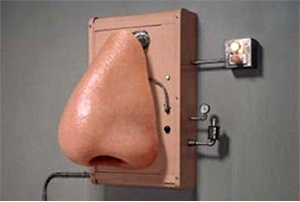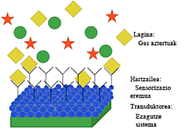|
NANOSENSORS - SUPER SMELL
|
|
|
Smell is the sense provoked by a stimulus received at the olfactory sensory system. Our sense of smell detects particles suspended in the air and to do so, olfactory organs, "noses", provided with a series of sensors generate a specific signal (electrical in this case) for each particle and the brain finally associates that signal with a specific smell. This principle is also used to create any type of sensors which enable us to specifically identify chemicals.
The reactive or sensory area is made up of a recognition component and an integrated system which facilitates processing the signal produced and generating a mechanical, electrical, optical response or other type of response.
Nanosensors Nanosensors are hyper-sensitive detectors capable of identifying nanoparticles.
Electrical nanosensor: When particles interact with the nanosensor, the change in electrical current trough it is used to identify the composition.
Microarrays or biochips used for DNA detection and sequencing; nanonose for cancer detection in human breath; nanosensors to detect pollution, explosives, drugs, food expiry; nanosensors to detect blood alcohol concentration compatible with smartphone, etc.
Dogs trained to detect explosives or toxic products; pigs capable of finding truffles buried under the soil; iridescent butterflies with chemical/heat sensors on their wings; or sharks capable of smelling blood.
|















